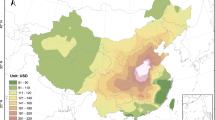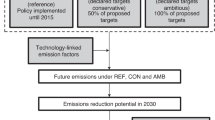Abstract
Both energy production and consumption can simultaneously affect regional air quality, local water stress and the global climate. Identifying the air quality–carbon–water interactions due to both energy sources and end-uses is important for capturing potential co-benefits while avoiding unintended consequences when designing sustainable energy transition pathways. Here, we examine the air quality–carbon–water interdependencies of China’s six major natural gas sources and three end-use gas-for-coal substitution strategies in 2020. We find that replacing coal with gas sources other than coal-based synthetic natural gas (SNG) generally offers national air quality–carbon–water co-benefits. However, SNG achieves air quality benefits while increasing carbon emissions and water demand, particularly in regions that already suffer from high per capita carbon emissions and severe water scarcity. Depending on end-uses, non-SNG gas-for-coal substitution results in enormous variations in air quality, carbon and water improvements, with notable air quality–carbon synergies but air quality–water trade-offs. This indicates that more attention is needed to determine in which end-uses natural gas should be deployed to achieve the desired environmental improvements. Assessing air quality–carbon–water impacts across local, regional and global administrative levels is crucial for designing and balancing the co-benefits of sustainable energy development and deployment policies at all scales.
This is a preview of subscription content, access via your institution
Access options
Access Nature and 54 other Nature Portfolio journals
Get Nature+, our best-value online-access subscription
$29.99 / 30 days
cancel any time
Subscribe to this journal
Receive 12 digital issues and online access to articles
$119.00 per year
only $9.92 per issue
Buy this article
- Purchase on Springer Link
- Instant access to full article PDF
Prices may be subject to local taxes which are calculated during checkout




Similar content being viewed by others
Data availability
Data used to perform this study can be found in the Supplementary Information. Any further data that support the findings of this study are available from the corresponding authors upon reasonable request.
References
Gies, E. The real cost of energy. Nature 551, S145–S147 (2017).
Zhang, J. F. et al. Environmental health in China: progress towards clean air and safe water. Lancet 375, 1110–1119 (2010).
Sheehan, P., Cheng, E. J., English, A. & Sun, F. H. China’s response to the air pollution shock. Nat. Clim. Change 4, 306–309 (2014).
Zhang, Q. et al. Asian emissions in 2006 for the NASA INTEX-B mission. Atmos. Chem. Phys. 9, 5131–5153 (2009).
Zhang, C. & Anadon, L. D. Life cycle water use of energy production and its environmental impacts in China. Environ. Sci. Technol. 47, 14459–14467 (2013).
Macknick, J., Newmark, R., Heath, G. & Hallett, K. C. Operational water consumption and withdrawal factors for electricity generating technologies: a review of existing literature. Environ. Res. Lett. 7, (2012).
Ou, X. M. & Zhang, X. L. Life-cycle analyses of energy consumption and GHG emissions of natural gas-based alternative vehicle fuels in China. J. Eng. 2013, 268263 (2013).
Buonocore, J. J. et al. Health and climate benefits of different energy-efficiency and renewable energy choices. Nat. Clim. Change 6, 100–105 (2016).
Siler-Evans, K., Azevedo, I. L., Morgana, M. G. & Apt, J. Regional variations in the health, environmental, and climate benefits of wind and solar generation. Proc. Natl Acad. Sci. USA 110, 11768–11773 (2013).
Webster, M., Donohoo, P. & Palmintier, B. Water–CO2 trade-offs in electricity generation planning. Nat. Clim. Change 3, 1029–1032 (2013).
Qin, Y. et al. Air quality, health, and climate implications of China’s synthetic natural gas development. Proc. Natl Acad. Sci. USA 114, 4887–4892 (2017).
Peer, R. A. M., Garrison, J. B., Timms, C. P. & Sanders, K. T. Spatially and temporally resolved analysis of environmental trade-offs in electricity generation. Environ. Sci. Technol. 50, 4537–4545 (2016).
Wang, C. Y., Wang, R. R., Hertwich, E. & Liu, Y. A technology-based analysis of the water–energy–emission nexus of China’s steel industry. Resour. Conserv. Recycl. 124, 116–128 (2017).
Chang, Y., Huang, R. Z. & Masanet, E. The energy, water, and air pollution implications of tapping China’s shale gas reserves. Resour. Conserv. Recycl. 91, 100–108 (2014).
Hertwich, E. G. et al. Integrated life-cycle assessment of electricity-supply scenarios confirms global environmental benefit of low-carbon technologies. Proc. Natl Acad. Sci. USA 112, 6277–6282 (2015).
Gingerich, D. B., Sun, X. D., Behrer, A. P., Azevedo, I. L. & Mauter, M. S. Spatially resolved air-water emissions tradeoffs improve regulatory impact analyses for electricity generation. Proc. Natl Acad. Sci. USA 114, 1862–1867 (2017).
Enhanced Actions on Climate Change: China’s Intended Nationally Determined Contributions (National Development and Reform Commission, 2015); http://www4.unfccc.int/Submissions/INDC/Published%20Documents/China/1/China’s%20INDC%20-%20on%2030%20June%202015.pdf.
National Statistic Data (National Bureau of Statistics of China, 2017); http://data.stats.gov.cn/easyquery.htm?cn=C01
Zhang, C., Anadon, L. D., Mo, H. P., Zhao, Z. N. & Liu, Z. Water–carbon trade-off in China’s coal power industry. Environ. Sci. Technol. 48, 11082–11089 (2014).
Liu, Z. et al. A low-carbon road map for China. Nature 500, 143–145 (2013).
Huang, R. J. et al. High secondary aerosol contribution to particulate pollution during haze events in China. Nature 514, 218–222 (2014).
Strengthen the Work Plan for Prevention and Control of Atmospheric Pollution in Energy Industry (National Energy Administration, 2014); http://www.nea.gov.cn/133338463_14002098575931n.pdf
Thirteenth Five Year Plan for China’s Natural Gas Development (National Development and Reform Commission, 2016). http://www.ndrc.gov.cn/gzdt/201701/t20170119_835571.html.
China: International Energy Data and Analysis (US Energy Information Administration; 2015); https://www.eia.gov/beta/international/analysis.php?iso=CHN
Qin, Y., Tong, F., Yang, G. & Mauzerall, D. L. Challenges of using natural gas as a carbon mitigation option in China. Energ. Policy 117, 457–462 (2018).
NDRC. Thirteenth Five Year Plan for China’s Energy Industry. http://www.ndrc.gov.cn/zcfb/zcfbghwb/201701/W020170117350627940556.pdf (2016).
Dong, W. J. et al. China–Russia gas deal for a cleaner China. Nat. Clim. Change 4, 940–942 (2014).
Paltsev, S. & Zhang, D. W. Natural gas pricing reform in China: getting closer to a market system? Energ. Policy 86, 43–56 (2015).
Yang, C. J. & Jackson, R. B. Commentary: China’s synthetic natural gas revolution. Nat. Clim. Change 3, 852–854 (2013).
Fu, Z. H. Lifecycle analysis of carbon emissions from coal-based synthetic natural gas and comparison with other gas sources (in Chinese). Natural Gas Ind. 30, 1–5 (2010).
Qin, Y., Edwards, R., Tong, F. & Mauzerall, D. Can switching from coal to shale gas bring net carbon reductions to China. Environ. Sci. Technol. 51, 2554–2562 (2017).
Jaramillo, P., Griffin, W. M. & Matthews, H. S. Comparative life-cycle air emissions of coal, domestic natural gas, LNG, and SNG for electricity generation. Environ. Sci. Technol. 41, 6290–6296 (2007).
Ding, Y. J., Han, W. J., Chai, Q. H., Yang, S. H. & Shen, W. Coal-based synthetic natural gas (SNG): a solution to China’s energy security and CO2 reduction? Energ. Policy 55, 445–453 (2013).
Pacsi, A. P., Alhajeri, N. S., Zavala-Araiza, D., Webster, M. D. & Allen, D. T. Regional air quality impacts of increased natural gas production and use in Texas. Environ. Sci. Technol. 47, 3521–3527 (2013).
Chen, Z. B., Qian, F. Y. & Chen, D. J. Evaluation of the use of coal-based synthetic natural gas for haze prevention in China (in Chinese). J. Environ. Sci. (China) 35, 2615–2622 (2015).
Song, P. et al. Analysis on the contribution of coal-to-SNG to reducing the discharge of air pollutants (in Chinese). Coal Chem. Ind. 44, 15–18 (2016).
Chang, Y., Huang, R., Ries, R. J. & Masanet, E. Life-cycle comparison of greenhouse gas emissions and water consumption for coal and shale gas fired power generation in China. Energy 86, 335–343 (2015).
Feng, K. S., Hubacek, K., Pfister, S., Yu, Y. & Sun, L. X. Virtual scarce water in China. Environ. Sci. Technol. 48, 7704–7713 (2014).
Pfister, S., Koehler, A. & Hellweg, S. Assessing the environmental impacts of freshwater consumption in LCA. Environ. Sci. Technol. 43, 4098–4104 (2009).
Tang, T. China’s Natural Gas Imports and Prospects Prepared for Energy Research Institute, National Development and Reform Commission, China (2014); https://dukespace.lib.duke.edu/dspace/bitstream/handle/10161/8459/MP_Final_Tang.pdf?sequence=1
World Energy Outlook 2012. Water for Energy: Is Energy Becoming a Thirstier Resource? (International Energy Agency, 2012). https://www.iea.org/media/publications/weo/WEO_2012_Water_Excerpt.pdf
Technically Recoverable Shale Oil and Shale Gas Resources: An Assessment of 137 Shale Formations in 41 Countries Outside the United States (US Energy Information Administration, 2013); https://www.eia.gov/analysis/studies/worldshalegas/pdf/overview.pdf
Jiang, Y. China’s water scarcity. J. Environ. Manage. 90, 3185–3196 (2009).
Sanders, K. T. Critical review: uncharted waters? The future of the electricity-water nexus. Environ. Sci. Technol. 49, 51–66 (2015).
Byers, E. A., Hall, J. W., Amezaga, J. M., O'Donnell, G.M . & Leathard, A. Water and climate risks to power generation with carbon capture and storage. Environ. Res. Lett. 11, 024011 (2016).
Fouquet, R. Path dependence in energy systems and economic development. Nat Energy 1, 16098 (2016).
Karambelas, A., Holloway, T., Kiesewetter, G. & Heyesc, C. Constraining the uncertainty in emissions over India with a regional air quality model evaluation. Atmos. Environ. 174, 194–203 (2018).
Peng, W., Yang, J., Wagner, F. & Mauzerall, D. L. Substantial air quality and climate co-benefits achievable now with sectoral mitigation strategies in China. Sci. Total Environ. 598, 1076–1084 (2017).
Klimont, Z. et al. Global anthropogenic emissions of particulate matter including black carbon. Atmos. Chem. Phys. 17, 8681–8723 (2017).
Su, S. S., Li, B. G., Cui, S. Y. & Tao, S. Sulfur dioxide emissions from combustion in China: from 1990 to 2007. Environ. Sci. Technol. 45, 8403–8410 (2011).
Acknowledgements
Y.Q. thanks the Woodrow Wilson School of Public and International Affairs at Princeton University for her graduate fellowship and the International Institute for Applied Systems Analysis (IIASA) for her 2016 Young Scientists Summer Program fellowship. E.B. thanks IIASA for his Postdoctoral Fellowship funding. Y.Q. acknowledges earlier discussions with G. Kiesewetter, Z. Klimont, J. Cofala and P. Rafaj.
Author information
Authors and Affiliations
Contributions
Y.Q. and D.L.M. designed the study, Y.Q. performed the research, L.H.-I., E.B., K.F., F.W. and W.P. contributed data for analysis, Y.Q., L.H.-I., E.B., K.F., and D.L.M. analysed data and Y.Q., D.L.M. and L.H.-I. wrote the paper.
Corresponding authors
Ethics declarations
Competing interests
The authors declare no competing interests.
Additional information
Publisher’s note: Springer Nature remains neutral with regard to jurisdictional claims in published maps and institutional affiliations.
Supplementary information
Supplementary Information
Supplementary Methods, Supplementary Tables 1–9, Supplementary Figures 1–10, Supplementary References 1–53
Rights and permissions
About this article
Cite this article
Qin, Y., Höglund-Isaksson, L., Byers, E. et al. Air quality–carbon–water synergies and trade-offs in China’s natural gas industry. Nat Sustain 1, 505–511 (2018). https://doi.org/10.1038/s41893-018-0136-7
Received:
Accepted:
Published:
Issue Date:
DOI: https://doi.org/10.1038/s41893-018-0136-7
This article is cited by
-
Global assessment of the carbon–water tradeoff of dry cooling for thermal power generation
Nature Water (2023)
-
Deploying green hydrogen to decarbonize China’s coal chemical sector
Nature Communications (2023)
-
The expansion of natural gas infrastructure puts energy transitions at risk
Nature Energy (2022)
-
Environmental benefits and household costs of clean heating options in northern China
Nature Sustainability (2021)
-
Health and economic impacts from PM2.5 pollution transfer attributed to domestic trade in China: a provincial-level analysis
Environmental Science and Pollution Research (2021)



